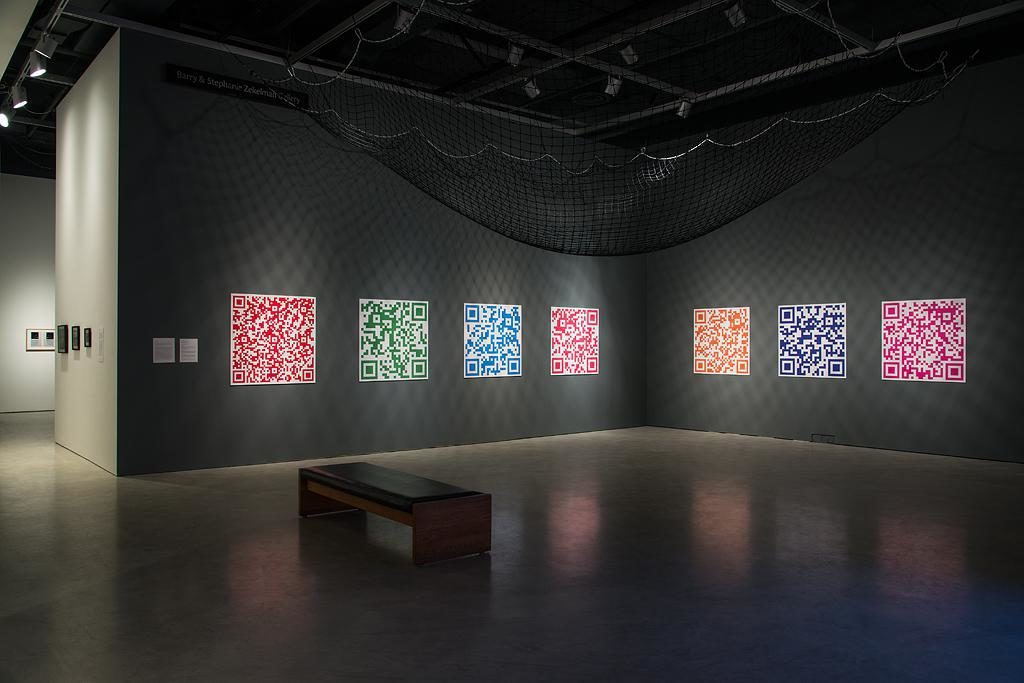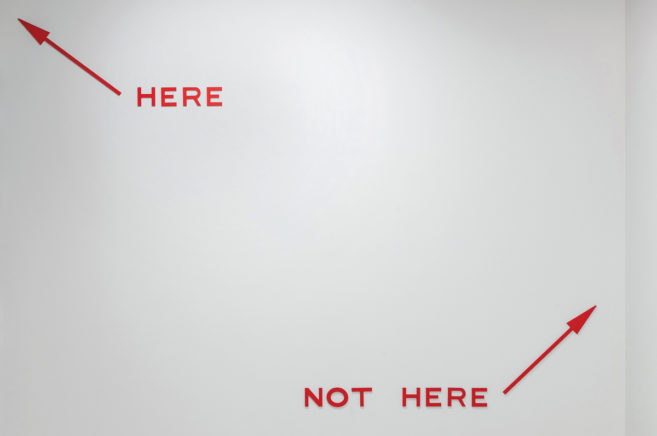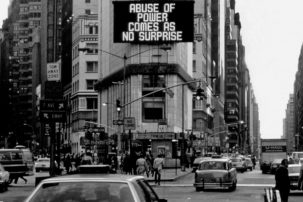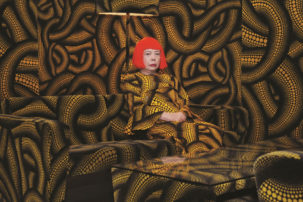As soon you get off the train, you can smell that Windsor is a border city. The Hiram Walker & Sons distillery, located next to the Via Station, gives off a yeasty, alcoholic odor—a civic cologne that Walker, an American, applied when he set up his booze empire in Windsor during U.S. prohibition. The odor has lingered long since.
West of the distillery, there’s more evidence of Windsor-Detroit’s border culture: stops for Windsor Transit’s “Tunnel Bus”—a route that charges an extra $1.75 to take residents over (or well, under) the border to Detroit—and a view of the Ambassador Bridge. The skyscrapers of GM’s global headquarters on the American side seem less than a mile away from a Canadian bungalow sporting a stars-and-stripes flag and “God Bless the U.S.A.” sign. A huge iPhone ad fills the side of a Detroit building; since the image faces Windsor, Apple gets to advertise in two markets for the price of one.
Yet this border relationship hasn’t always been complementary. Downtown, historical plaques mark the site where a troop of William Lyon Mackenzie supporters who laid siege to the city via Detroit in 1838 were beaten back by the Brits, with more than 10 of the rebels executed and 18 sent to Tasmania (!). The War of 1812 also happened in the area, and Windsor prides itself on having been a terminus for the Underground Railroad when slavery was the US norm.
Windsor is therefore a rich territory in which to situate any exhibition about border cultures, and Srimoyee Mitra—the Art Gallery of Windsor’s curator of contemporary art—is to be commended organizing a series of exhibitions there: “Border Cultures: Part One (homes, land),” of 2013; “Border Cultures: Part Two (work, labour),” on now; and “Border Cultures: Part Three (about security and surveillance),” due to take place in 2015.
One of the difficulties of doing “Border Cultures” in Windsor, though, is it’s challenging for any artwork to compete with the area itself—at least as far as a tourist like me is concerned. In the Detroit River, the two large cities it separates and unites, and the bridge, tunnel, and related accoutrements, nature meets culture to produce a ne plus ultra installation (not to mention ongoing “performance”) work on this theme.
Another challenge Mitra takes on is attempting to pull off a show that mixes global art stars with local, lesser-known artists. Works by the former can bring a sense of institutional credibility—as well as formal mastery—but too many, or a poor selection, can create a generic “greatest hits” feeling. In parallel, works by the latter can be very engaging—often more so than work by jet-setting better-knowns—but may risk amateurism.
So while I wondered if “Border Cultures: Part 2” sometimes cast too wide a net (in both the international and hyperlocal directions), I was also stirred by many elements in the mix.
One work that made an impression—particularly because I saw a large cargo ship sailing down the river on my way to the gallery—was From Gulf to Gulf to Gulf (2009–2013). Shot by members of the Indian collective C.A.M.P. and by sailors of small ships that move between India, Iran, Somalia and the UAE, the film’s vignettes encompass many moods: from romantic (dolphins racing in sunshine-shot water) to realistic (a goat being skinned during meal preparation), and from forbidding (a boat on fire, with crew jumping out) to endearing (a sailor pointing the camera at himself, as if to assert, I am here). Visual quality also varies, with some of the grainier footage shot on sailors’ cellphones. The results underline that what is marked on a map as separate territories can be knit together through mass and individual experiences.
Another film—Racing Home (1996) by late filmmaker and critic Marian McMahon— speaks wonderfully to the particularities of growing up in Windsor in the 1950s and 1960s. It includes real-life stories of driving back across the bridge with packages of US-bought underwear and fabric stuffed under T-shirts and winter jackets to avoid customs duties. Racing Home also addresses a narrative of Windsorian “purity” and “goodness” (illustrated by comparison to a more “troubled” Detroit) that was reinforced in McMahon whenever she reflected upon the tale of the Underground Railroad—a narrative which positioned Canada as promised land, even if many kinds of racism still existed (and continue to exist) here. This mixture of personal and political, nostalgic and critical, makes Racing Home appealing, as does as its straightforward address of the local context.
The situating of Racing Home in a larger installation devoted to McMahon’s archive and the work of her partner, artist Philip Hoffman, also suggests art can be an (overlooked) form of labour in the Windsor region.
A different view on life in Southern Ontario comes across in the film Migrant Dreams by Min Sook Lee. Presented in the gallery as an 11-minute excerpt of a longer, in-progress documentary, the film focuses on a group of female migrant workers from Mexico who live 22 to a house for 6 months of the year in Canada. In this, we get a complex look at migrant labour—one that is by turns heartbreaking and heartening. At multiple points, women who have left young babies behind in Mexico become tearful. “You come to help your children get ahead, but at the same time, your heart is destroyed,” one says through a translator. But another explains that her work in Canada—paid more than double relative to what she can earn at home—has allowed her to own a house in Mexico for her and her kids. This and a related installation by Deborah Barndt help to make visible some of the people whose hard, less-than-minimum-wage labour permits many Canadians to enjoy affordable “locally grown” fruits and vegetables.
Webs of unfair labour that bind us, near and far, also come to the fore in Windsor artist Andrea Slavik’s project The Things We Cannot Live Without (2013). It consists of six large, colourful QR codes and a black net suspended from the ceiling. Through an iPad mini, provided by the artist at the AGW info desk, I scanned the first code and was presented with images of the suicide nets installed by Foxconn—famously one of Apple’s biggest suppliers—following a rash of deaths at one of its Chinese facilities. Other code scans bring up Apple’s “supplier responsibility” page, which emphasizes its “high supplier standards” and touts 95 per cent compliance in 2013 on a maximum 60 hour workweek; a New York Times slideshow about Foxconn factory towns; letters and videos of complaint by the group Students and Scholars Against Corporate Misbehaviour; and a Jon Stewart segment, posted to a Chinese website, about Foxconn’s ethical transgressions (including an 18-cents-an-hour pay rate and 35-hour shifts for some workers).
Slavik’s wall text indicates that she hoped not only to call Foxconn and Apple out on their poor labour practices, but to indicate the complicity of those in the gallery—and those in the arts in general, who tend to be big Mac users. Indeed, as I held the iPad, felt its cool, smooth metal exterior in my hands, and swiped its glossy display, I felt implicated in a bodily way that typically I don’t in QR-code art.
Slavik’s referencing of the growth of manufacturing overseas also has direct links to the situation of cities like Detroit and Windsor that were previously industrial mavericks, now starved for new sources of jobs. Is there such a thing as an ethically produced computer or smartphone? If so, what would it cost? And who would make it? What good are area gains made by unions when halfway across the globe, the people who make some of the world’s most in-demand objects are fired if they attempt to form a union? The cheerful pink and blue hues of that iPhone ad over the river in Detroit read differently to me after experiencing Slavik’s piece.
Exiting the gallery proper into an atrium overlooking the Detroit River, I saw Statics—a stack of Commodore 64 monitors that local artists and record-store owners Kero and Annie Hall are using to display local “landmarks.” In the bright sunlight, I couldn’t see the images clearly. But it was terrific to see the discarded technology—scraps of a rust-belt region—stacked up against still-glossy Detroit towers sporting the logos of Chrysler and the Detroit Tigers.
Though space doesn’t allow it, I wish more works could have been shown in this atrium/overlook context—like Dylan Miner’s partially crushed canoe, which is surrounded by decorated hammers and headphones that relay tales of Detroit-Windsor as one of the first sites of Indigenous urbanization.
“Border Cultures” also includes live events. This Saturday, April 5, offers an in-gallery conversation with C.A.M.P. and Philip Hoffman, followed by a community-based session coordinated by Radiodress (aka Reena Katz) at New Work Field Street Collective in Detroit.
Though I know I have missed out on a big part of “Border Cultures” by not being able to partake of these live programs, I still had a new appreciation for the complexity of borders—particularly in the remarkable Windsor-Detroit context—when I left the AGW and headed back to Walkerville for the train.









